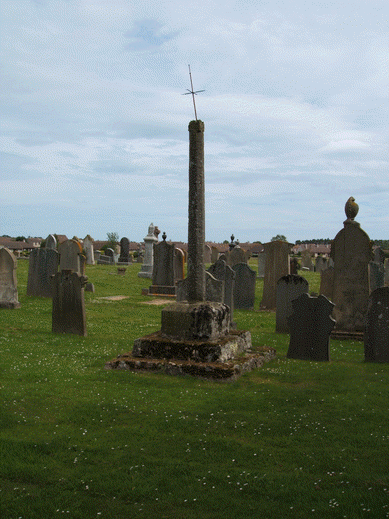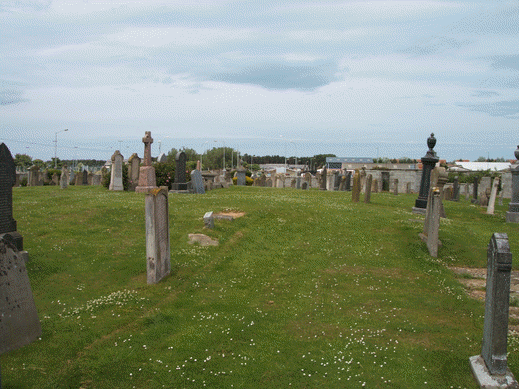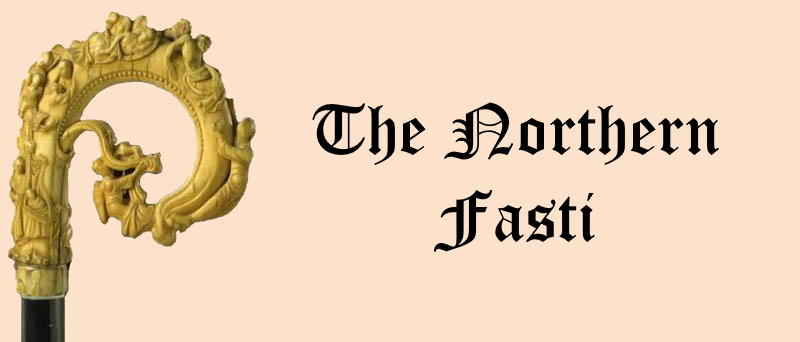Elgin Deanery
Kinneddar
Parish Church: OS Ref: NGR NJ 223696 H.E.S. No: NJ26NW 10 Dedication: St Gervadius.
Associated Chapels: St Gerardine's Hermitage {NGR: NJ 238708}.
We find Kinneddar variously called Kennedor, Kinnaider, and Kynnedor in older sources.1
A visitor to the location today will see little to impress the imagination but, historically, Kinneddar was a community of some considerable importance. Recent archaeological discoveries show that it dates back at least to Pictish times, if not much further. It is situated at the eastern extremity of what was a virtual island which lay between the waters of the Loch of Spynie and the Moray Firth.2
Kinneddar has been the subject of sporadic archaeological excavation over many years - most recently, in 2017, by Aberdeen University - but it has not yet benefited from a comprehensive programme of investigation covering the wider area, such as has been carried out at Portmahomack. Work is hampered by the 'modern' cemetery, and by the fact that recent housing developments encroach upon the site from the north and east. However, the 2017 work, at least, resulted in some important evidence being derived from radiocarbon dating. This evidence suggests significant activity at Kinneddar from as early as the late 6th century and certainly by the 7th century. The importance, and possible royal associations of the settlement,3 would have drawn the early 'peregrine' saints like moths to a candle and it is not surprising that in the first days of Christianity, Kinneddar was one of the pioneer muinntirs in these northern lands.4
Kinneddar was one of a number of Christian communities of the Early Church which are to be found on the shores of Spynie Loch and current scholarship suggests that Kinneddar, especially, was a site of major significance in the production of stone carvings of an ecclesiastical nature. The late W. Ashley Bartlam, a well-known Elgin architect, made a study of quarrying and the quarry-stones of Morayshire which underlined the importance of the high-quality sandstones to be found here and which, for many hundreds of years, have proved to be almost perfect material for the mason's chisel.5 It has been suggested recently that the Christian community at Kinneddar was possibly what some would call a monastery but which should be more correctly described as a muinntir6. Similarities have been noted between the outline, interior-layout, and size of the vallum which surrounded the community's buildings at Kinneddar, and what has been revealed at Iona. This has led some scholars to suggest that the community here was founded from the Iona community but, currently, there is no incontrovertible evidence to confirm this.
At this point, it is important to note that the parish church of Kinneddar carried a dedication to a most uncommon saint - St Gervadius (St Gerardine). A number of scholars, including Thomas Clancy, have asserted that Gervadius is a form of the name Gartnait or Gartnaidh.7 Professor Noble and his colleagues suggest that, "the Gartnait dedication at Kinneddar celebrated a local or regional saint or an important Pictish secular figure associated with the site."8 If we follow the second suggestion, that we have the memorial or commemoration of an important secular figure, then we should look no further than the Pictish King List which includes no less than three candidates who are known to have been Ard Ri of the Pictish confederation - Gartnaidh Mac Domneth (584-599), Gartnaidh Mac Wid (631-635), and Gartnaidh Mac Donnel (657-663). All three were Ard Ri during the period which has been suggested for the founding of the Pictish community at Kinneddar. But the jury is still out on this matter.

A considerable amount has been published recently which has greatly expanded our understanding of the fragments of Pictish carving that have been found in the vicinity of Kinneddar. This is not the place to go into the detail of what has been found since other authors have presented exhaustive studies on the subject and much of it has been published and made available on the internet.9 However, we would be right to conclude that the evidence of these stones does much to support the major importance of the Kinneddar community in the Pictish era.

Richard [of Lincoln], a clerk in the service of King William I, was elected Bishop of Moray on Sunday, 1st March 1187. Two weeks later, he was consecrated by Hugh, bishop of St Andrews, in the cathedral at St Andrew's, on the 15th March. His predecessor, Simon de Tosny (1171-1184), had died on 17 September 1184 and the interregnum was the direct result of the major insurrection which had been raised against King William by his rival, Donald MacWilliam. It was only after the king had quelled this rebellion that he was able to secure the election of his most trusted clerk to the bishopric. Richard could have been forgiven for thinking that his elevation to the episcopacy was something of a 'poisoned chalice'. The diocese was not yet well-founded and, in particular, its finances were in a poor state. Richard found that his predecessor had used the church at Birnie as his cathedral and an 'episcopal residence' had been built a little to the east of the community that had existed at Birnie since ancient times. After only a short time, the new bishop translated his cathedral from Birnie to Kinneddar and an 'episcopal residence' was constructed, just to the north of the church. The question immediately arises as to what were the bishop's reasons for moving his cathedral to Kinneddar. One factor may have been the easy access to sea-travel which Kinneddar afforded. However, Richard seems to have moved his cathedral again, after only a short period, to the parish church of Spynie,10 although the Bishop's Residence/Castle at Kinneddar continued in use for some time afterwards.
During his campaigns in the North in 1308, Robert the Bruce, seized and burned the castles at Inverness and Nairn and then continued by doing the same to Kinneddar Castle. After his second visit to the area, in 1303, King Edward I of England had left the castles of Elgin, Duffus, and Kinneddar under the control of English garrisons, making them obvious 'targets' for Bruce and his allies. It is not clear if the bishop's residence ever fully recovered from this destruction. It is a sad thing that little or nothing is left now of what was such an impressive structure. Archaeological finds indicate that the castle was somewhat 'unique' in Scotland in that it was laid out following what has been called a concentric ground-plan, consisting of a roughly hexagonal set of defences. Ruins of the castle were still visible on-site as late as 1734 and were described as being, "a central tower enclosed by two concentric hexagonal walls".11 The church beside the castle seems to have escaped the attentions of Bruce's army - it had no strategic value, unlike the castle, and its sanctity would probably have been respected.
There are records in the Vatican which show that Bishop Simon de Tosny attempted to make a gift of the church of Kinneddar to the priory of St Andrews some time before he died. Confirmation of this supposed gift is provided by Pope Lucius III in 1183, and by subsequent Popes until 1248.12 This, however, was apparently no more than common form, the church having been assigned (1208 x 15), in the 'Magna Carta' of Bishop Bricius, as the prebend of the Treasurer, along with the church of Essil.
The parish of Kinneddar was annexed to the neighbouring parish, to the west - Ogston - on 17th February, 1669.13 A new church was built at Drainy to serve the united congregations, however, the manse and glebe remained at Kinneddar. It would seem that the graveyards, at Kinneddar and Ogston, both continued in use after the amalgamation of the parishes.
This small stretch of coast was famous for the excellence of the white-fishing to be had and boats used to operate from the beaches at Covesea and Stotfield. There is a very sad tale told regarding the events of Christmas Day, Thursday 25th December, 1806. Even now it is well-remembered in the community as The Stotfield Disaster and the local custom that it generated stopped any fishing boat putting to sea on Christmas Day ever again! 14
| Name | OS Grid Ref. | Extent | Including | Comment |
|---|---|---|---|---|
| Meikle & Little Drainy | NJ 201690 | 5 ploughgates | Under the runways of RAF Lossiemouth. | |
| Little Drainy | NJ 204673 | Salterhill. 15 | ||
| Ardowett | NJ 225670 | 4 ploughgates | Ardivot. | |
| Newtoune | NJ 205697 | Possibly Newlands. | ||
| Muirtoune | NJ 2226683 | 2 ploughgates | Muirton. | |
| Information from Ross (2003)16 with locations added by David Murray. | ||||
1187 (15 November) At Ferrara, Pope Gregory VIII takes into his protection (with other gifts from different individuals) the church of Kinneddar from the gift of Simon {de Tosny}, bishop of Moray , being the property now of the prior and brethren of St Andrews. [St Andrews Liber, 62-67]
1214 (22 December) At the Lateran, Pope Innocent III writes to the dean and chapter of Moray, taking 'the church' with its persons and goods into his protection. Kynedor (Kinneddar) is one of the churches listed. [Moray Reg., no. 47]
1227 (1 February) At 'Kenedor', a charter was signed recording an agreement between the Bishops of Moray (Andrew) and Ross (Richard) regarding the churches of Kiltarlity and Ardersier. The charter is signed by a considerable number of clergy from the diocese of Ross. It is most likely that this was one of two copies - one, signed by the clergy of Moray, being kept in the cathedral treasury at Rosemarkie (Ross diocese); the other, signed by the clergy of Ross at Rosemarkie, being transported to Elgin and kept amongst the Moray papers which eventually made up the Registrum Episcopatus Moraviensis. This charter shows that even as late as the episcopacy of Andrew de Moravia, in 1227, Kinneddar was still being used as an episcopal residence. [Moray Reg., no. 75]
1237 (May) At 'Kenedor', an agrement was reached between Robert, Treasurer of Moray {whose prebend was Kinneddar} and prior William and his convent of Urquhard Priory, {consisting of four other monks} as to an agreeable distribution of the teinds of the lands of Meft (Meft
1248 (19 June) At Lyon, Pope Innocent IV, following the example of his predecessors, takes the property of the priory of St Andrews into his protection, including the church of Kinneddar. [St Andrews Liber, 98-102]
1263 (February) At 'Kenedor', Eufemia, wife of the late Walter de Moravia, lord of Duffus, grants to the cathedral of Moray and Archebaldo, bishop of Moray, all the land which she has in Ross, namely a third part of the lands of Clonys (Clyne) next to Dyngvall (Dingwall) which land the lord Walter, formerly her lord, gave to the said church for the support of two chaplains in the cathedral of Elgyn to pray for the living and the dead, in the same way that Fergus of Ardrossan gave lands to the cathedral of Moray, now collated. [Moray Reg., no. 216]
1269 (May) At 'Kenedor', Archibald, bishop of Moray, grants to Reginald le Chen, yngr., lord of Duffus and his betrothed, Marie, daughter of Freskyn de Moravia, all his lands of Strathnauir (Strathnaver) in Caithness diocese which Johanna, wife of Freskyn, conveyed to the church of Moray for the support of two chaplainries, namely of Langeval and Rossewal; the tofts of Dovyr, Achenedess, Clibr', Ardovyr, and Cornafern. Set at feuferme for 12 marks sterling per annum, half at Pentecost and half at Michaelmas, for the support of the two chaplains {in the cathedral}. [Moray Reg., no. 126]
1294 (Saturday 30 October) At Kinneddar, Archibald, bishop of Moray, issues a charter in favour of William de Fedderate and his wife, the Lady Christina of Moray {moray Reg., no. 131].
1545 (16 May) The lands of Drainie were granted by Patrick Hepburn, Bishop of Moray, with the consent of his Chapter, to James Innes and Catherine Gordon, his spouse. [Moray Reg., nos. 347, 348, 454]
St Gerardine's Hermitage.
Kinneddar (along with Essil) formed the prebend of the Treasurer of the cathedral from 1207x08, when Bishop Bricius established his chapter at the new cathedral at Spynie. Consequently, the Treasurer was rector of Kinneddar, which arrangement continued up to the Reformation. The parish church was served by a vicar perpetual.
1. We have chosen to use the spelling "Kinneddar" since that is what has been used for many years by the Ordnance Survey. However, some writers choose to use Kineddar and others Kinnedar. Return
2. For a more detailed description, including a map, refer to the article "The Loch of Spynie" in the Articles section of this website. Return
3. Noble, G. et. al. (2019) Kinneddar: a major ecclesiastical centre of the Picts, Edinburgh: PSAS Vol. 148 (2019), 113-145, 140. Return
4. Noble, G. et. al. (2019) Kinneddar: a major ecclesiastical centre of the Picts, Edinburgh: PSAS Vol. 148 (2019), 113-145, 137. Return
5. Bartlam, W.A. (2001) Stones and Quarrying in Moray, Published by the Author. Copies available at Elgin Museum and in the archives of Historic Environment Scotland. Return
6. Armit, I. & Büster, L. (2020) Darkness Visible: The Sculptor's Cave, Covesea, from the Bronze Age to the Picts, Edinburgh: Society of Antiquaries of Scotland, 73; Carver, M. (2016) Portmahomack: Monastery of the Picts, Edinburgh: Edinburgh University Press, 2nd edition, 157, 220. Return
7. Clancy, T. (2008) 'Deer and the early church in North-Eastern Scotland', in Forsyth, K (ed.) Studies on the Book of Deer, Dublin: Four Courts Press, 363-97, 378; Mackinlay, J.M. (1906) Ancient Church Dedications in Scotland: Non-Scriptural Dedications, Edinburgh: David Douglas, 214. Return
8. Noble (2019), 141. Return
9. Readers may investigate the Kinneddar Stones in: Noble, G. et. al. (2018) Kinneddar: a major ecclesiastical centre of the Picts, Edinburgh: PSAS, Volume 148 (2018), 113-145; Henderson, G. & Henderson, I. (2004) The Art of the Picts: Sculpture and Metalwork in Early Medieval Scotland, New York: Thames & Hudson, Inc., 49, 52, 130-31, 146, 194, 203, 206, 212, 216, 218. Return
10. In a charter of King William, issued on 26 December 1199, reference is made to, "ecclesie Sancte Trinitatis de episcopatu Morau(iensi) et Ric(ardo) episcopo". Scholars have taken this reference to suggest that the cathedral was now the church of the Holy Trinity (which is accepted as being Spynie). The inference is that Richard had already moved his cathedral to Spynie by the time of this charter. [RRS, vol. ii, no. 421; Moray Reg., 17.] Return
11. Shaw, L (1882) The History of the Province of Moray, vol. ii, 55. For further details, see the CANMORE database at https://canmore.org.uk/site/16459/kinneddar-bishops-palace Return
12. Gregory VIII writes that his predecessors, Popes Lucius II, Eugene III, Adrian IV, Alexander III and Lucius III, had provided their protection to the property of the priory of St Andrews and that he was following their example. [St Andrew's Liber., 62-67] Return
13. Scott, H. (1926) Fasti Ecclesiae Scoticanae, Vol. 6, Edinburgh: Oliver and Boyd, 382. Return
14. See https://en.wikipedia.org/wiki/Stotfield_fishing_disaster
and The Stotfield Disaster of 1806 This article was authored by Mr Bruce Bishop, FSAScot, of the Association of Scottish Genealogists and Resrearchers in Archives [ASGRA], and is reproduced here with his permission. Return
15. J.F.S Gordon who enlarged and edited Lachlan Shaw's "The History of the Province of Moray" considered that Little Drainie was what is now called Salterhill
16. Ross, A. (2003) The Province of Moray, c.1000-1230, unpublished PhD thesis presented to Aberdeen University, Vol 2, 40.Return
17.Shaw, L. (1882) The History of the Province of Moray: New Edition, Vol2., Glasgow: Thomas D. Morison, 62-63. Return
18. Mackintosh, H.B. (1914) Elgin Past and Present: a historical guide, Elgin: J.D. Yeadon, 268-9. Return
e-mail: admin@cushnieent.com
© 2021 Cushnie Enterprises

